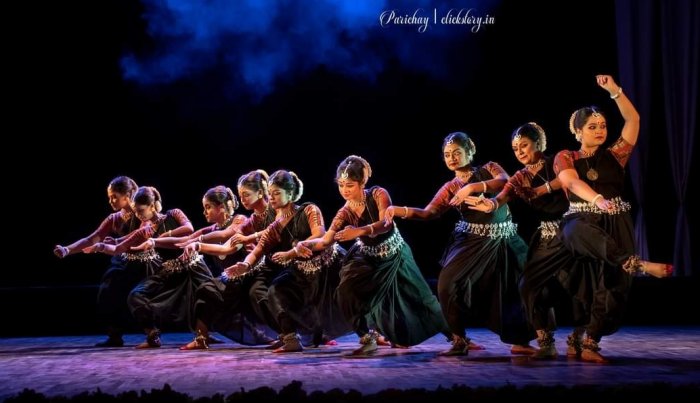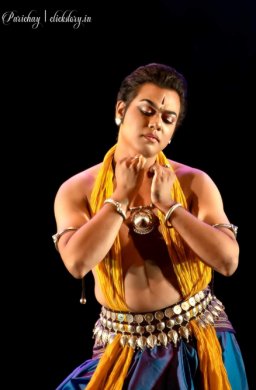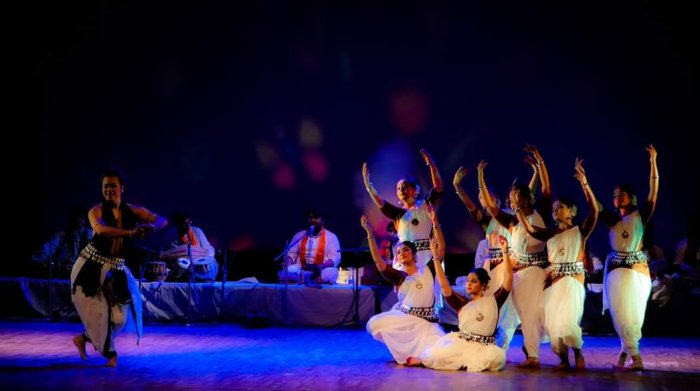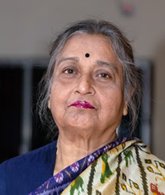
|   |

|   |
Ravash 2022 by Sankalpa Nrityayan - Dr. Nita Vidyarthi e-mail: nitavidyarthi@gmail.com Photos courtesy: Subikash Mukherjee September 22, 2022 The annual festival Ravash 2022 by Sankalpa Nrityayan opened with a bang at the Rabindra Sadan, Kolkata, recently with a bouquet of quality Odissi dance performances by the students of Sankalpa Nrityayan in the first half and an impressive collaborative production by the seniors of the institution and artistes from Shantiniketan in the second. Organised, guided and mounted by the well-known city based, aesthetically passionate Odissi dancer Subikash Mukherjee, who heads Sankalpa Nrityayan, and is at present under the tutelage of Guru Ratikant Mohapatra, the two and a half hour program boasted not only of the full maturity of the art Subikash learnt from his Guru but also the keen sense of lights, colour, excellent costumes and impeccable organisation. In addition to this, the performance of the large number of tiny tots and the juniors proved his patience, sensitivity and affection required in handling children and his teaching ability with an able team to assist the little learners.  Mahadeva The inaugural dance 'Lahari' was a well synchronised piece playing with rhythm, angik and hastamudras by a group of 19 dancers. This was followed by 'Mahadeva', a thundering tribute to the renowned vocalist Debashis Sarkar, a star musician and composer lost during the Covid pandemic and missed especially by the dance fraternity of the city. Mahadeva was set to the song "Jai Mahesh" in Debashis's voice with his own composition, and performed by well-trained seniors in ragamalika and talamalika. The choreography describing the primordial being Mahadeva was a vibrant combination of nritta and nritya by Subikash embellished with some signature movements of Ratikant like the images of diagonals. And the dancers delighted with their undiluted grammar of execution of the artistic designs. They looked stunning in black Odissi costumes adorned with highly polished silver jewellery. A series of classical Odissi presentations like "Hari Om" (with two male dancers among a group of girls) and "Patadeep Pallavi" by three seniors set to Pradip Das's music and Guru Ratikant's choreography spoke of their confidence, technical skill and grip on rhythm. It was a real joy to watch twenty odd tiny, highly disciplined girls clad in red, dancing in perfect coordination, without missing a single beat or step to the chanting of slokas of Vighnaraja Saraswati, Surya and others, set to ragas like Darbari, Bhairavi, Todi in talam adi. They entertained and also surprised the overcapacity Rabindra Sadan audience with their Odia abhinaya of the song "Kahi gale murali phunka", till now seen in adults performing it as a solo. Every lyric of the song was demonstrated with the hastas with full seriousness. Subikash must be lauded for training them.  Subikash Mukherjee The first impression of the number 'Basant' with 25 dancers spreading across the sprawling stage was really the joy of spring with a splurge of yellow and green. The Pallavi set to raga Basant, ektali did have moments of monotony due to the large group with extended bits and repetitions. Nevertheless, it kept the spectators engaged with an overall neat presentation. Spiced with the awestruck expression of the onlookers, the dramatic entry of Subikash Mukherjee as the lovelorn Krishna prepared the audience for one of the memorable stage deliveries of Jayadeva's ashtapadi "Priye Charusheele". Choreographed by Guru Kelucharan Mohapatra set to Pt Bhubaneswar Mishra's music, this mystical, luminous, sublime ashtapadi requires immense understanding of the nuances, care, and commitment to unfold the poetry of the lyrics and lasya in all its forms. The dancer's poetic interpretation of the lyrics accompanied by music showed connection between the artistic import and its technical brilliance. The dancer's expressive eyes matched beautifully with the choreography and so did his sense of costume as Krishna. And Subikash was at his best. The first segment concluded with the ritualistic Moksha. 'Bandhu hey Aamar' - With you till eternity - was an ambitious at the same time courageous project by Sankalpa Nrityayan and the artistes from Shantiniketan. Conceived and choreographed by Subikash, the production tried to justify death and face it not as a denial of life but as a process to embrace an uninvited guest (Kono bishadmoy abogahon noye barong ek nimontronhin athiti according to him) touching his concept on Tagore's immortal composition "Maran re tuhu momo Shyam saman". The title was from a part of song of Tagore. The subject is not easy and requires maturity, understanding of omnipresent reality and realisation and the acquaintance of interpretation of death by great saints, thinkers and philosophers together with an in-depth knowledge of the Upanishads. Nevertheless, the production is garlanded with choreographed songs of Tagore, readings and poems from his work. The constraint to bring out the textual, contextual and sub-textual as well as the narrative landscape for the choice of more suitable and soulful songs from the vast range of Tagore's composition on death was the difficulty with their tala patterns and required a lot of effort to choreograph them. But the dancers proved their training and Subikash his mettle in the items presented.  Bandhu hey Aamar There were some beautiful moments and patterns in "Sudhu jawa asha shudu srotey bhasa" (infinite movement or flow to and fro), the Brahmosangeets "Nutan pran dao pranosakha" and Subikash's solo "Gobhiro rajani namilo hridayae ar kolahol nai" (Deep night descends in the mind and there is silence) and a fine meaningful portrayal of the song, "Ke jabi parey" (To cross over the river Vaitarini) by senior dancer Moumita Sengupta. The final surrender to the Almighty was aesthetically portrayed by Subikash clutching a deep blue cloth (perhaps personifying Krishna), completely possessed with emotion and ecstasy. Scripted by Abhijit Bose from Jalpaiguri, the multicity production had live music with vocals by Jhinuk Talapatra and Anand Vardhan and fine musical support by Debayan Majumder (esraj), Chanchal Nandy (tabla and sree khol) and Biswayan Roy (synthesiser), all from Shantiniketan; narration by Amrita Pandit and Sourav Chakravarty and Odissi mardala by Uttam Mondal from Kolkata. A well attempted production with a difference.  Dr. Nita Vidyarthi is a veteran critic of performing arts and writes on dance, music and theatre in leading publications. |